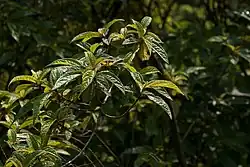Oreocnide pedunculata
| Oreocnide pedunculata | |
|---|---|
 | |
| Leaves | |
| Habit | |
| Scientific classification | |
| Kingdom: | Plantae |
| Clade: | Tracheophytes |
| Clade: | Angiosperms |
| Clade: | Eudicots |
| Clade: | Rosids |
| Order: | Rosales |
| Family: | Urticaceae |
| Genus: | Oreocnide |
| Species: | O. pedunculata |
| Binomial name | |
| Oreocnide pedunculata | |
| Synonyms[2] | |
| Villebrunea pedunculata Shirai | |
Oreocnide pedunculata, the purple woodnettle or longpedicel woodnettle, is a species of flowering plant in the family Urticaceae, native to south-central and southern Japan, the Ryukyu Islands, and Taiwan.[2][3] A shrub or small tree 2 to 5 m (7 to 16 ft) tall, it is found growing in valleys and forest edges at elevations ranging from 100 to 1,200 m (300 to 3,900 ft).[4] Its leaves are an important food source for Formosan rock macaques (Macaca cyclopis) and Japanese macaques (Macaca fuscata).[5][6]
References
- ^ Botanic Gardens Conservation International (BGCI).; IUCN SSC Global Tree Specialist Group. (2019). "Oreocnide pedunculata". IUCN Red List of Threatened Species. 2019: e.T145347333A145351310. doi:10.2305/IUCN.UK.2019-2.RLTS.T145347333A145351310.en. Retrieved 21 June 2023.
- ^ a b "Oreocnide pedunculata (Shirai) Masam". Plants of the World Online. Royal Botanic Gardens, Kew. Retrieved 21 June 2023.
- ^ "長梗紫苧麻". 認識植物. Academia Sinica Biodiversity Research Center. 2023. Retrieved 21 June 2023.
- ^ "长梗紫麻 chang geng zi ma". Flora of China. efloras.org. 2023. Retrieved 20 June 2023.
- ^ Su, Hsiu-Hui; Lee, Ling-Ling (2001). "Food Habits of Formosan Rock Macaques (Macaca cyclopis) in Jentse, Northeastern Taiwan, Assessed by Fecal Analysis and Behavioral Observation". International Journal of Primatology. 22 (3): 359–377. doi:10.1023/A:1010799410911. S2CID 13615863.
- ^ Agetsuma, Naoki (1995). "Dietary selection by Yakushima macaques (Macaca fuscata yakui): The influence of food availability and temperature". International Journal of Primatology. 16 (4): 611–627. doi:10.1007/BF02735284. S2CID 32449460.
